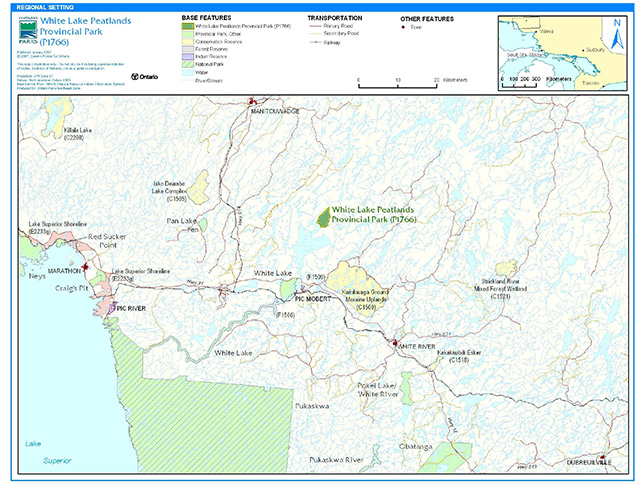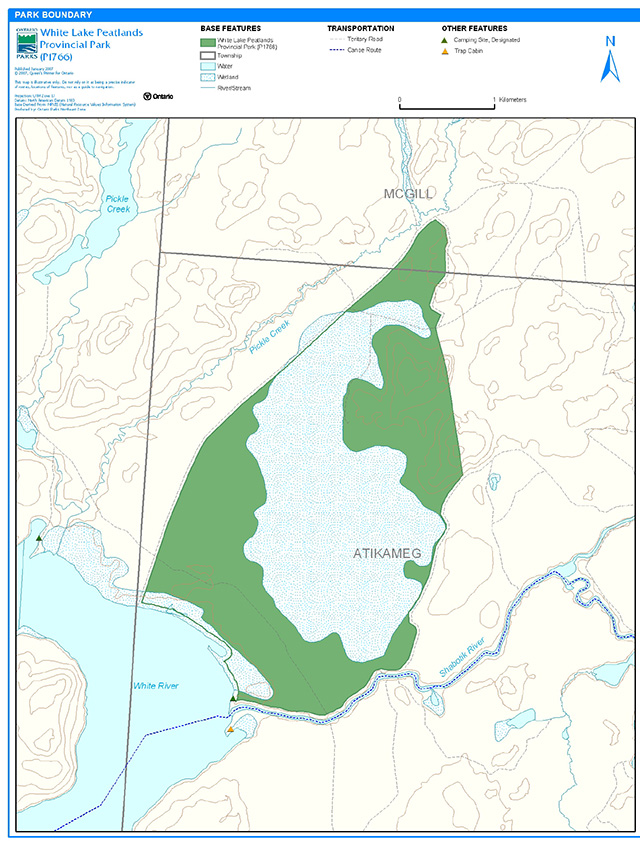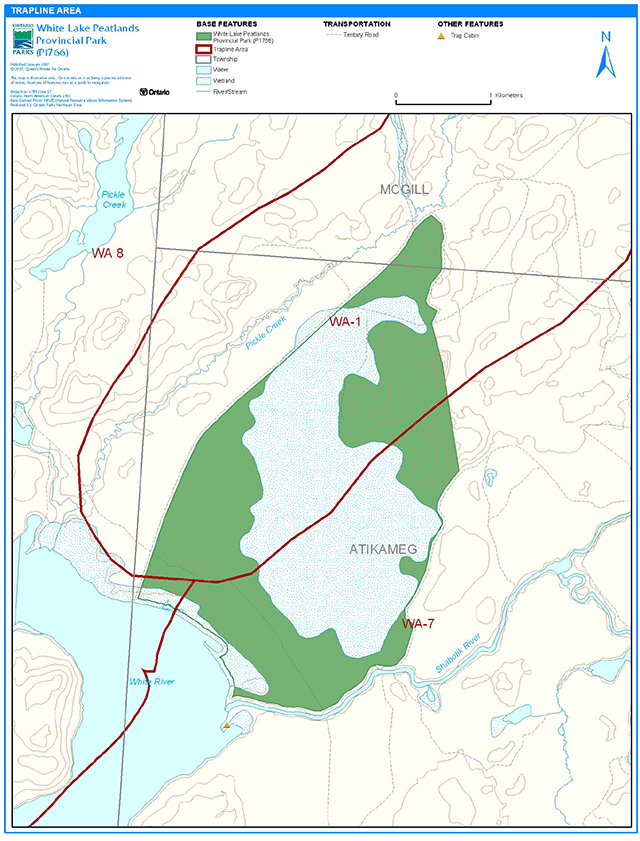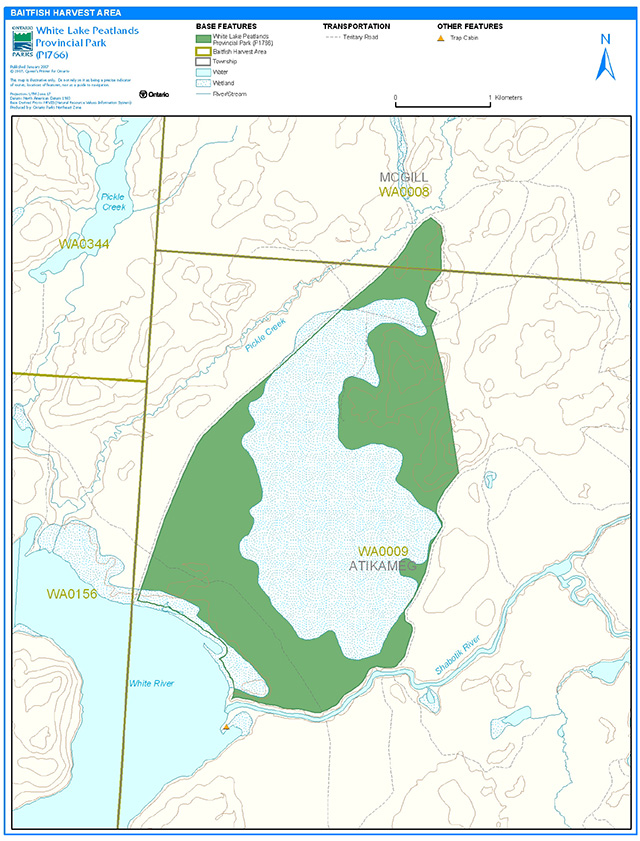White Lake Peatlands Provincial Park Management Statement
This document provides policy direction for the protection, development and management of White Lake Peatlands Provincial Park and its resources.
Interim Management Statement
2007
Approval statement
I am pleased to approve this Interim Management Statement for White Lake Peatlands Provincial Park. This park was regulated under the Provincial Parks Act in February 1995 (O. Reg. 52/97).
This Interim Management Statement provides direction for the protection and management of White Lake Peatlands Provincial Park.
Signed by:
Paul Bewick, Manager
Northeast Zone
Ontario Parks
Date: February 12, 2007
1.0 Introduction
White Lake Peatlands Provincial Park is located in McGill and Atikameg townships and is approximately 40 kilometres northwest of White River (Figure 1). This 992-hectare protected area is designated as a nature reserve class park. The park was named for an extensive peatland bog that developed over sand deposits which formed thousands of years ago by retreating glaciers (Figure 2).
1.1 Objectives
White Lake Peatlands Provincial Park will be managed consistent with the two objectives for nature reserve class provincial parks:
Protection: To protect provincially significant elements of the natural and cultural landscapes of Ontario.
Heritage Appreciation: To provide opportunities for exploration and appreciation of the outdoor natural and cultural heritage of Ontario.
2.0 Management context
The purpose of this Interim Management Statement (IMS) is to provide direction to ensure the custodial management of park resources. Future park planning may be undertaken as required to provide direction on significant decisions regarding resource stewardship, development, operations and permitted uses.
Park management will follow direction from:
- Provincial Parks Act (1990) and regulations
- Ontario Provincial Parks Planning and Management Policies (OMNR 1992)
- Ontario’s Living Legacy Land Use Strategy and policy clarifications (OMNR 2000), amendments, and related direction
- Crown Land Use Policy Atlas (OMNR 2004a).
In addressing custodial management obligations to protect park values and ensure public health and safety, Ontario Parks will ensure that policy and Environmental Assessment Act (1990) requirements are implemented.
2.1 Environmental Assessment
As a part of the Ontario Ministry of Natural Resources (MNR), Ontario Parks is a public sector agency which is subject to the Environmental Assessment Act. Park management will be carried out in accordance with legislation, policies, and guidelines that are required under A Class Environmental Assessment for Provincial Parks and Conservation Reserves (OMNR 2005).
3.0 Park features and values
White Lake Peatlands Provincial Park protects representative landform types for this part of the province. The main feature of the park is the large peatland bog. Other features of the park are a sand beach and backshore lagoon, and a low levee ridge on the west bank of the Shabotik River (OMNR 1997).
Figure 1: Regional Context

Enlarge figure 1: Regional Context
Figure 2: Park Boundary

Enlarge figure 2: Park Boundary
3.1 Geological features
White Lake Peatlands Provincial Park encompasses a large wetland overlying glaciolacustrine fine-grained deposits, which are likely silt and clay with a minor amount of sand. Levee deposits, most likely composed of sand and silt, occur adjacent to the banks of Shabotik River. A treeless wetland and raised beach complex occur along the shoreline of Shabotik Bay on the northern part of White Lake. Bedrock is exposed in the northeastern portion of the park as small topographic knobs. These appear to be bare or mantled with a thin veneer of glacial sediment, likely till or lacustrine deposits. The bedrock consists of massive to foliated intrusive granitic rocks which lie within the Wawa Subprovince of the Superior Province, which is a part of the Canadian Precambrian Shield. The site was identified for its life science features; there are no identified earth science values (Kor 2007).
3.2 Biological features
A detailed survey and analysis of the biological features and values of White Lake Peatlands Provincial Park has not been completed to date.
White Lake Peatlands Provincial Park, located at the north end of White Lake, encompasses an extensive peatland feature. Wet, organic terrain has developed on glaciofluvial outwash sand deposits which extend to the northeast along the Shabotik River valley. The peatland is considered to be fairly mature, due to the masking of subsurface flow patterns by treed vegetation. This peatland has probably matured from treed fen to conifer swamp. Portions of the peatland are black spruce-dominated conifer swamp, while other areas are larch-dominated conifer swamp (Noble 1983).
The peatland is bordered by rock knob uplands to the north and is surrounded by old, cut-over forest on its periphery (Noble 1983). On the shore of the White River, within the park, is a sand beach which is backed by a lagoon containing marshes, sand beach barrens, a willow thicket-covered beach ridge, meadow marshes, shrub fens, larch swamp, larch fen, and black spruce swamp. The levee on the on west bank of the Shabotik River contains a trembling aspen forest with scattered white pine (OMNR 1997).
3.3 Cultural setting
A detailed survey and analysis of the cultural history and features of White Lake Peatlands Provincial Park has not been completed to date.
Any future planning will be within the context of a provincial framework, A Topical Organization of Ontario History (OMNR 1974). In addition, updates and discussions with First Nations, other agencies and stakeholders may be carried out to identify cultural heritage values and features within the park and their significance. This information may be used to develop management guidelines to conserve and protect representative archaeological and historical values and features, or to provide direction for further research.
3.4 Recreation
Policies for nature reserve class parks provide a policy base to allow nature processes to function freely, within the constraints of public safety and the need to protect values within and adjacent to the nature reserve. The protection and maintenance of environmental values are fundamental to the management of White Lake Peatlands Provincial Park.
A detailed survey and analysis of the recreational features of White Lake Peatlands Provincial Park has not been conducted to date. The park may offer a variety of low-intensity recreational uses, such as canoeing, hiking, nature appreciation, and exploring. Unauthorized snowmobile and all-terrain vehicle (ATV) use may occur in this area. Future management planning will review all uses, including snowmobile and ATV use, to ensure that park features and values are protected, and to assess the potential for these uses to conflict with park values and other uses.
4.0 Aboriginal uses
White Lake Peatlands Provincial Park lies within the Robinson-Superior Treaty of 1850.
First Nations have expressed interest in and have shared knowledge of the park and surrounding area. Aboriginal communities have used the area for hunting, trapping, fishing, gathering and travel. These uses may continue, subject to public safety, conservation and other considerations.
Any communications and cooperation between Aboriginal communities and the MNR for planning and operations purposes will be done without prejudice to any future discussions or negotiations between the government of Ontario and Aboriginal communities.
5.0 Stewardship policies
The removal, damage or defacing of Crown properties, natural objects, relics, and artefacts is not permitted in provincial parks (Provincial Parks Act).
Non-native species will not be deliberately introduced into the park. Where non-native species are already established and threaten park values (i.e., has become invasive), a strategy to control the species may be developed (OMNR 1992).
5.1 Terrestrial ecosystems
5.1.1 Harvesting
Commercial forest operations are not permitted within the park (OMNR 1992).
The harvest of non-timber forest products such as club moss, Canada yew, etc., will not be permitted within the park (OMNR 1992).
Existing authorized wild rice harvesting may continue. New operations will not be permitted.
There are no fuelwood cutting permits currently issued for the park. New permits will not be issued (OMNR 2000).
5.1.2 Insects and disease
Insects and diseases may be managed where the aesthetic, cultural, or natural values of the park are threatened. Control measures will follow guidelines established by the Ontario Ministry of the Environment (MOE) and MNR. Whenever possible, biological control measures will be given preference over the use of chemicals (OMNR 1992).
5.1.3 Fire
White Lake Peatlands Provincial Park is located within the Boreal Fire Management Zone. In accordance with existing provincial park policy and the Forest Fire Management Strategy for Ontario, forest fire protection will be carried out in the park as on surrounding lands (OMNR 2004b). Whenever feasible, MNR's Forest Fire Management program will use techniques that minimize damage to the landscape, such as limiting the use of heavy equipment or limiting the number of trees felled during response efforts (OMNR 2004b).
5.1.4 Wildlife management
White Lake Peatlands Provincial Park is located within Wildlife Management Unit 21B. The removal or harassment of non-game animals is not permitted (Provincial Parks Act).
Hunting
Sport hunting is not permitted in the park (OMNR 1992; 2000). The harvest of bullfrogs or snapping turtles is illegal in provincial parks.
Bear Mnagement Areas
Commercial bear hunting is not permitted in White Lake Peatlands Provincial Park. There are no bear management area (BMA) allocations within the park. New BMAs will not be established.
Trapping
White Lake Peatlands Provincial Park includes portions of three trapline areas: WA-8, WA-1, and WA-7 (Figure 3). These traplines are presently allocated. Since trapping is not permitted in nature reserve class parks, existing commercial fur harvesting operations will be phased out by December 31, 2009. New operations, including trap cabins and trails, will not be permitted (OMNR 2000; 2003).
5.1.5 Adjacent land
Forestry
The land adjacent to the park is within the White River Forest Management Unit (MU) #60. This MU is currently managed by Domtar Inc. The forest management plan shows the park as not within the land base for forest management.
Provincial parks
White Lake Provincial Park (P1506/P1506e) is located south of White Lake Peatlands Provincial Park. White Lake Provincial Park, a natural environment class park, was regulated in 1963. A popular park for anglers, travellers, and beach-goers, this park is also a staging area for backcountry canoeing on White River south to Pukaskwa National Park.
Conservation reserves
The conservation reserve (CR) network complements the provincial park system by protecting representative natural areas and special landscapes. The Kwinkwaga Ground Moraine Uplands CR (C1509) is located south of White Lake Peatlands Provincial Park. This large CR was burned over by the 1999 Crocker Lake Fire. This CR contains moderately broken ground moraine, as well as weakly broken ground moraine, as well as many hills, lakes, and creeks. The Kwinkwaga River passes through the northern portion of the CR.
General use areas
One general use area, the Integrated Multiple Resources Management General Use Area (G2694), surrounds White Lake Peatlands Provincial Park. This general use area is a sprawling 1,329,898 hectares in size. The primary activities in this area are forest management, mineral exploration, mining, hydroelectric power generation, tourism, and Crown land recreation. The land use intent is dependent on MNR's capacity to influence resource management activities on the lands that are managed by Wagner Ontario Forest Management.
5.1.6 Land disposition
New land disposition for the private use of individuals or corporations will not be permitted (OMNR 1992; 2000).
Figure 3: Trapline Areas

Enlarge figure 3: Trapline Areas
Land use permits, licenses of occupation, and unauthorized occupations
There are no land use permits (LUP) associated with White Lake Peatlands Provincial Park.
There are no licenses of occupation and no known unauthorized occupations within White Lake Peatlands Provincial Park.
Patent land
White Lake Peatlands Provincial Park is surrounded by Crown Land. There are no parcels of patent land within or abutting the park.
Boat caches
There are no authorized boat caches within White Lake Peatlands Provincial Park. Boats are not permitted to be left unattended in the park without written permission from the superintendent under the authority of the Provincial Parks Act.
5.1.7 Access and crossings
Access
White Lake Peatlands Provincial Park is accessible by tertiary roads and by waterway from White River and Shabotik River, via White Lake or the White Lake Canoe Route. The canoe route passes adjacent to the park boundary on the south end.
Roads
The majority of White Lake Peatlands Provincial Park is bounded by a tertiary road along the park periphery, and other tertiary roads pass into and through the park boundary.
Where existing forest and/or tertiary access roads are essential for continued access beyond the park for forest management, or recreational purposes, and alternative road access does not exist, or road relocation is not feasible, existing roads will continue to be available for access.
Continued use will include maintenance and may include upgrades (OMNR 2004a). Ontario Parks is not responsible for the maintenance or upgrade of any roads within the park boundary.
Any proposed development, maintenance or upgrading of existing roads must meet all Environmental Assessment Act requirements.
Utility corridors
There are no utility corridors within the park.
All public utilities (e.g., gas pipelines, transmission lines, communications towers) must avoid park lands wherever possible. New utility corridor crossings may be necessary to maintain essential public services (OMNR 2004a).
Any future utility corridors proposed through the park, where park lands are unavoidable, will be reviewed on a case-by-case basis. Protection of park features and values will be priority and all requirements of the Environmental Assessment Act will be met.
Recreational trails
There are no authorized trails within White Lake Peatlands Provincial Park. New trails (e.g. hiking) may be developed if the need arises (OMNR 2004a). Any proposed development within the park is subject to Environmental Assessment Act requirements.
Unauthorized snowmobile and ATV use may occur in this area. Future management planning will review all uses, including snowmobile and ATV use, to ensure that park features and values are protected, and to assess the potential for these uses to conflict with park values and other uses. Off-trail ATV and snowmobile use is not permitted.
5.2 Aquatic ecosystems
Sustaining quality water resources is integral to the protection of park and adjacent land values. The MOE enforces applicable legislation and regulations for water quality.
5.2.1 Water management
There are no hydro developments, water control structures, or diversions within the park. New commercial hydroelectric developments will not be permitted (OMNR 2000).
Fisheries management
Fisheries management will complement the maintenance and enhancement of native, self-sustaining fish populations (OMNR 1992).
Sport fishing
Sport fishing is permitted within the park. This activity is governed by legislation and regulations in the Fish and Wildlife Conservation Act and the Fisheries Act (1985). The Recreational Fishing Regulations Summary contains details on the applicable regulations for this area.
Commercial baitfish harvesting
Portions of two baitfish harvesting areas are within White Lake Peatlands Provincial Park: WA0008 and WA0009 (Figure 5). Neither of the baitfish harvest areas are allocated. New baitfish licenses within the park boundary will not be permitted (OMNR 2000; 2003).
Fish stocking
Fish stocking is not permitted in White Lake Peatlands Provincial Park.
6.0 Operations policies
6.1 Recreation management
Future planning, with full public consultation, will review direction on motorized and non-motorized recreation uses.
6.1.1 Motorized recreation
Motorboats
The use of motorboats is not permitted in White Lake Peatlands Provincial Park (OMNR 1992).
Aircraft
Aircraft landings are not permitted in the park (OMNR 1992).
Snowmobiles
The use of snowmobiles is not permitted in White Lake Peatlands Provincial Park. Off-trail snowmobile use is not permitted within the park. New snowmobile trails are not permitted.
All-terrain vehicles
There are no authorized ATV trails within the park boundary. Off-road use of ATVs will not be permitted within the park. New ATV trails will not be established.
6.1.2 Non-motorized recreation
Camping
Camping is not permitted in White Lake Peatlands Provincial Park.
Figure 5: Baitfish Harvesting Areas

Enlarge figure 5: Baitfish Harvesting Areas
Hiking
There are no authorized hiking trails within the boundaries of this provincial park. Unauthorized hiking trails and other non-mechanized trails may be permitted to continue unless such trails threaten park features and values, create user conflicts or raise safety and/or liability issues.
If there is an identified need, the development of new hiking trails may be considered. Trail infrastructure to protect park values and features may be permitted. Any proposed development within the park is subject to Environmental Assessment Act requirements.
Canoeing/kayaking
The White River Canoe Route, via Shabotik River and White River, passes adjacent to White Lake Peatlands Provincial Park but does not pass through it. Canoeing or kayaking may be permitted to continue, unless park features and values are threatened.
6.1.3 Emerging recreational uses
There are emerging recreational uses for which there is limited or no policy to deal with their management (e.g., adventure racing and geocaching). The park superintendent will use legislation, policy, and guidelines which are in place to manage emerging uses in the interim.
6.2 Development
There is no existing development within the park. Infrastructure to protect park features and values may be permitted and developed in response to use, environmental deterioration, and environmental protection requirements. Any proposed development within the park is subject to the Environmental Assessment Act.
6.3 Commercial tourism
New commercial tourism facilities are not permitted in White Lake Peatlands Provincial Park.
7.0 Cultural resources
An assessment of the cultural resources specific to the park has not yet been completed. The management of any cultural values within this park will be directed toward protection and heritage appreciation (OMNR 1992).
8.0 Heritage education
Literature and other supporting information may be developed to describe the park in the context of Ontario’s provincial park system. Boundary limits, significant heritage features and permitted uses of the may be included in park literature.
Prospective park visitors may be informed about the sensitivity and significance of park values through park literature.
9.0 Research
Scientific research by qualified individuals which contributes to the knowledge of natural or cultural history, or to environmental or recreational management, may be encouraged in the park. Ontario Parks will encourage institutions, such as universities, to undertake research projects.
All research programs will require the approval of Ontario Parks and are subject to park policy and other applicable legislation. Any materials removed from the park will remain the property of Ontario Parks.
Approved research activities and facilities will be compatible with the park’s protection objective. Any site which is affected by research will be rehabilitated as closely as possible to its original state. Environmental Assessment Act requirements will apply.
10.0 References
Environmental Assessment Act, 1990.
Fish and Wildlife Conservation Act, 1997.
Fisheries Act, 1985.
Kor, P.S.G., 2007. Earth Science Inventory Checklist: White Lake Peatlands P1766. Draft.
Migratory Birds Convention Act, 1997.
Noble, T., 1983. Ontario Nature Reserves Program – Life Science Inventory Checksheet: White Lake-Shabotik River: Peatland.
Ontario Ministry of Natural Resources, 1974. A Topical Organization of Ontario History. Historic Sites Branch Division of Parks.
Ontario Ministry of Natural Resources, 1992. Ontario Provincial Parks Planning and Management Policies. 1992 Update.
Ontario Ministry of Natural Resources, 1997. White Lake Peatlands Provincial Nature Reserve Fact Sheet.
Ontario Ministry of Natural Resources, 1999. Ontario’s Living Legacy Land Use Strategy. July 1999. Queen’s Printer for Ontario.
Ontario Ministry of Natural Resources, 2000. Ontario’s Living Legacy Land Use Strategy (Policy Clarification).
Ontario Ministry of Natural Resources, 2003. Directions for Commercial Resource Use Activities in Provincial Parks and Conservation Reserves. 5 pp.
Ontario Ministry of Natural Resources, 2004a. Crown Land Use Policy Atlas.
Ontario Ministry of Natural Resources (OMNR), 2004b. Forest Fire Management Strategy for Ontario.
Ontario Ministry of Natural Resources (OMNR), 2005. A Class Environmental Assessment for Provincial Parks and Conservation Reserves.
Ontario Ministry of Natural Resources, 2006. List of Forest Management Units (MU) in Ontario (2006-2007). Online. Accessed February 5, 2007. http://ontariosforests.mnr.gov.on.ca/spectrasites/Viewers/showArticle.cfm?id=C74F77D4-68C7-41A6-8D96FB6079073782&method=DISPLAYFULLNOBARNOTITLE_R&ObjectID=C74F77D4-68C7-41A6-8D96FB6079073782&lang=FR&lang=EN&lang=FR&lang=EN [link no longer active]
Provincial Parks Act, 1990.
11.0 Appendix A: Background information
| Name | White Lake Peatlands Provincial Park (P1766) |
|---|---|
| Classification | Nature Reserve |
| Ecoregion/Ecodistrict | 3E / 3E4 |
| OMNR Administrative Region/District | Northeast Region – Wawa District |
| Total Area (ha) | 992 |
| Regulation Date and Number | February 1995 (O. Reg. 52/97) |
Representation
Earth science:
White Lake Peatlands Provincial Park encompasses a large wetland overlying glaciolacustrine fine-grained deposits, which are likely silt and clay with a minor amount of sand. Levee deposits, most likely composed of sand and silt, occur adjacent to the banks of Shabotik River. A treeless wetland and raised beach complex occur along the shoreline of Shabotik Bay on the northern part of White Lake. Bedrock is exposed in the northeastern portion of the park as small topographic knobs. These appear to be bare or mantled with a thin veneer of glacial sediment, likely till or lacustrine deposits. The bedrock consists of massive to foliated intrusive granitic rocks which lie within the Wawa Subprovince of the Superior Province, which is a part of the Canadian Precambrian Shield. The site was identified for its life science features; there are no identified earth science values (Kor 2007).
Life science:
At the north end of White Lake is White Lake Peatlands Provincial Park, which encompasses an extensive peatland feature. Wet, organic terrain has developed on glaciofluvial outwash sand deposits which extend to the northeast along the Shabotik River valley. The peatland is considered to be fairly mature, due to the masking of subsurface flow patterns by treed vegetation. This peatland has probably matured from treed fen to conifer swamp. Portions of the peatland are Black Spruce-dominated conifer swamp, while other areas are Larch-dominated conifer swamp (Noble 1983).
The peatland is bordered by rock knob uplands to the north and is surrounded by old, cut-over forest on its periphery (Noble 1983). On the shore of the White River, within the park, is a sand beach which is backed by a lagoon containing marshes, sand beach barrens, a willow thicket-covered beach ridge, meadow marshes, shrub fens, Larch swamp, Larch fen, and Black Spruce swamp. The levee on the on west bank of the Shabotik River contains a Trembling Aspen forest with scattered White Pine (OMNR 1997).
A more detailed life science report is required for White Lake Peatlands Provincial Park.
Cultural resources:
There are currently no reports describing the cultural heritage of White Lake Peatlands Provincial Park.
Recreation:
There are currently no reports describing the recreational features of White Lake Peatlands Provincial Park; however, the park may offer a variety of low-intensity recreational uses, such as canoeing, hiking, nature appreciation and exploring. Unauthorized snowmobile and all-terrain vehicle (ATV) use may occur in this area. Future management planning will review all uses, including snowmobile and ATV use, to ensure that park features and values are protected, and to assess the potential for these uses to conflict with park values and other uses.
Inventories
| Survey Level | Earth Science | Life Science | Cultural | Recreational |
|---|---|---|---|---|
| Reconnaissance | Kor 2007 | Required | Required | Required |